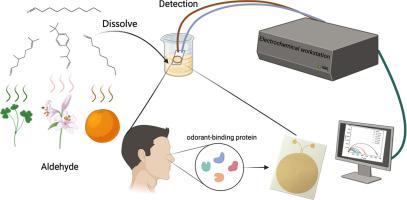当前位置:
X-MOL 学术
›
Anal. Chim. Acta
›
论文详情
Our official English website, www.x-mol.net, welcomes your feedback! (Note: you will need to create a separate account there.)
Highly sensitive and selective electrochemical biosensor using odorant-binding protein to detect aldehydes
Analytica Chimica Acta ( IF 5.7 ) Pub Date : 2024-07-02 , DOI: 10.1016/j.aca.2024.342932 Cong Peng , Yutong Sui , Chaohua Fang , Hongxu Sun , Wenxin Liu , Xinying Li , Chen Qu , Wenhui Li , Jiemin Liu , Chuandong Wu
Analytica Chimica Acta ( IF 5.7 ) Pub Date : 2024-07-02 , DOI: 10.1016/j.aca.2024.342932 Cong Peng , Yutong Sui , Chaohua Fang , Hongxu Sun , Wenxin Liu , Xinying Li , Chen Qu , Wenhui Li , Jiemin Liu , Chuandong Wu

|
Recently, various biosensors based on odorant-binding proteins (OBPs) were developed for the detection of odorants and pheromones. However, important data gaps exist regarding the sensitive and selective detection of aldehydes with various carbon numbers. In this work, an OBP2a-based electrochemical impedance spectroscopy (EIS) biosensor was developed by immobilizing OBP2a on a gold interdigital electrode, and was characterized by EIS and atomic force microscopy. EIS responses showed the OBP2a-based biosensor was highly sensitive to citronellal, lily aldehyde, octanal, and decanal (detection limit of 10 mol/L), and was selective towards aldehydes compared with interfering odorants such as small-molecule alcohols and fatty acids (selectivity coefficients lower than 0.15). Moreover, the OBP2a-based biosensor exhibited high repeatability (relative standard deviation: 1.6%–9.1 %, n = 3 for each odorant), stability (NIC declined by 3.6 % on 6th day), and recovery (91.2%–96.6 % on three real samples). More specifically, the sensitivity of the biosensor to aldehydes was positively correlated to the molecular weight and the heterocyclic molecule structure of the odorants. These results proved the availability and the potential usage of the OBP2a-based EIS biosensor for the rapid and sensitive detection of aldehydes in aspects such as medical diagnostics, food and favor analysis, and environmental monitoring.
中文翻译:

使用气味结合蛋白检测醛类的高灵敏度和选择性电化学生物传感器
最近,开发了各种基于气味结合蛋白(OBP)的生物传感器,用于检测气味和信息素。然而,关于各种碳原子数的醛的灵敏和选择性检测,存在重要的数据差距。在这项工作中,通过将 OBP2a 固定在金叉指电极上,开发了一种基于 OBP2a 的电化学阻抗谱 (EIS) 生物传感器,并通过 EIS 和原子力显微镜进行了表征。 EIS 响应表明,基于 OBP2a 的生物传感器对香茅醛、百合醛、辛醛和癸醛高度敏感(检测限为 10 mol/L),并且与小分子醇和脂肪酸等干扰气味剂相比,对醛类具有选择性。选择性系数低于0.15)。此外,基于 OBP2a 的生物传感器表现出高重复性(相对标准偏差:1.6%–9.1%,每种气味剂 n = 3)、稳定性(NIC 在第 6 天下降 3.6%)和回收率(第 6 天为 91.2%–96.6%)。三个真实样品)。更具体地说,生物传感器对醛类的敏感性与气味剂的分子量和杂环分子结构呈正相关。这些结果证明了基于 OBP2a 的 EIS 生物传感器在医学诊断、食品和偏好分析以及环境监测等方面快速、灵敏地检测醛类的可用性和潜在用途。
更新日期:2024-07-02
中文翻译:

使用气味结合蛋白检测醛类的高灵敏度和选择性电化学生物传感器
最近,开发了各种基于气味结合蛋白(OBP)的生物传感器,用于检测气味和信息素。然而,关于各种碳原子数的醛的灵敏和选择性检测,存在重要的数据差距。在这项工作中,通过将 OBP2a 固定在金叉指电极上,开发了一种基于 OBP2a 的电化学阻抗谱 (EIS) 生物传感器,并通过 EIS 和原子力显微镜进行了表征。 EIS 响应表明,基于 OBP2a 的生物传感器对香茅醛、百合醛、辛醛和癸醛高度敏感(检测限为 10 mol/L),并且与小分子醇和脂肪酸等干扰气味剂相比,对醛类具有选择性。选择性系数低于0.15)。此外,基于 OBP2a 的生物传感器表现出高重复性(相对标准偏差:1.6%–9.1%,每种气味剂 n = 3)、稳定性(NIC 在第 6 天下降 3.6%)和回收率(第 6 天为 91.2%–96.6%)。三个真实样品)。更具体地说,生物传感器对醛类的敏感性与气味剂的分子量和杂环分子结构呈正相关。这些结果证明了基于 OBP2a 的 EIS 生物传感器在医学诊断、食品和偏好分析以及环境监测等方面快速、灵敏地检测醛类的可用性和潜在用途。









































 京公网安备 11010802027423号
京公网安备 11010802027423号